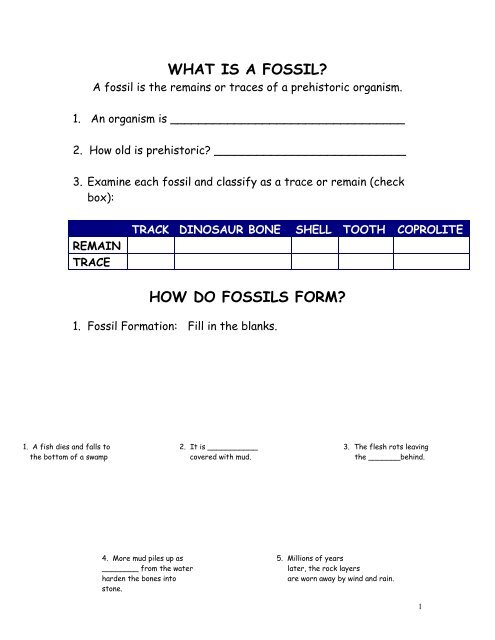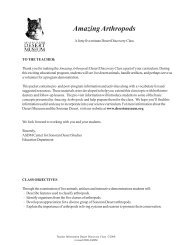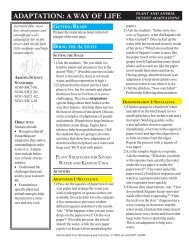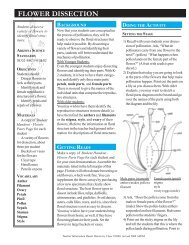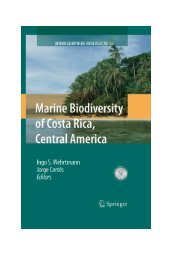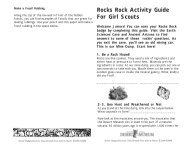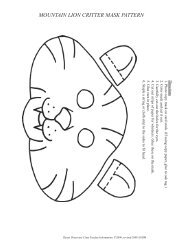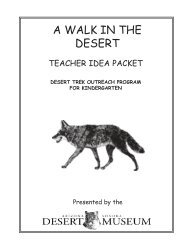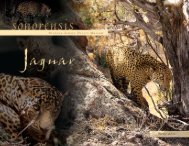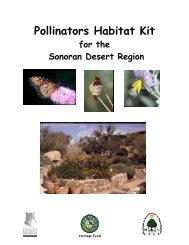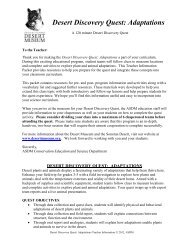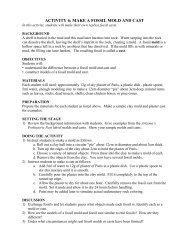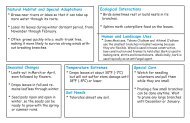ARIZONA'S PREHISTORIC PAST - Arizona-Sonora Desert Museum
ARIZONA'S PREHISTORIC PAST - Arizona-Sonora Desert Museum
ARIZONA'S PREHISTORIC PAST - Arizona-Sonora Desert Museum
You also want an ePaper? Increase the reach of your titles
YUMPU automatically turns print PDFs into web optimized ePapers that Google loves.
WHAT IS A FOSSIL?<br />
A fossil is the remains or traces of a prehistoric organism.<br />
1. An organism is _________________________________<br />
2. How old is prehistoric? ___________________________<br />
3. Examine each fossil and classify as a trace or remain (check<br />
box):<br />
REMAIN<br />
TRACE<br />
TRACK DINOSAUR BONE<br />
SHELL TOOTH COPROLITE<br />
HOW DO FOSSILS FORM?<br />
1. Fossil Formation: Fill in the blanks.<br />
1. A fish dies and falls to 2. It is ___________ 3. The flesh rots leaving<br />
the bottom of a swamp covered with mud. the _______behind.<br />
4. More mud piles up as 5. Millions of years<br />
________ from the water<br />
later, the rock layers<br />
harden the bones into<br />
are worn away by wind and rain.<br />
stone.<br />
1
2. Examine the specimens and circle the animals that are most likely to become fossils:<br />
jellyfish shell sponge worm<br />
3. Do fossils give us a complete picture of what lived in the past? ______ Why or why<br />
not? ___________________________<br />
PALEONTOLOGY<br />
1. Scientists who study fossils are called: _________________<br />
2. List 2 things scientists can learn by studying fossils:<br />
a.<br />
b.<br />
3. Scientists study _______________ animals today to understand<br />
_______________ animals from the past.<br />
2
ARIZONA’S <strong>PREHISTORIC</strong> <strong>PAST</strong><br />
<strong>Arizona</strong>'s ancient history is like a book. Each chapter tells a story! We will study<br />
ROCKS and FOSSILS to discover:<br />
• what <strong>Arizona</strong> looked like in the past<br />
• how we know it looked that way<br />
• who lived there (plants and animals)<br />
CHAPTER 1: ARIZONA’S ALL WET!<br />
WHEN DID IT HAPPEN? ____________________ (Paleozoic Era)<br />
WHAT DID IT LOOK LIKE?<br />
1. Examine limestone. What do you see?______________________________<br />
2. Study a collection of fossils to understand the ancient environment:<br />
a. These fossils tell us it was LAND or WATER?<br />
b. Crinoids tell us it was SALT or FRESH water?<br />
c. Corals tell us it was WARM or COLD water<br />
d. Animals that did not burrow tell us it was QUIET WATER or<br />
STRONG WAVES?<br />
e. Microscopic fossils tell us it was SHALLOW or DEEP water?<br />
3. Using this evidence, describe <strong>Arizona</strong>'s ancient environment during this<br />
time: __________________________________________________<br />
WHO LIVED HERE?<br />
1. Examine a fossil CRINOID:<br />
a. Name a living relative of crinoids _________________________.<br />
b. What part of a crinoid is usually preserved? ________________.<br />
3
2. Examine a fossil BRACHIOPOD:<br />
a. List 2 ways brachiopods differ from clams: _________________<br />
__________________________________________________<br />
3. Examine a fossil HORN CORAL:<br />
a. What did horn corals eat? ______________________________<br />
b. Why did so many filter feeders live in <strong>Arizona</strong>'s ancient ocean? __<br />
__________________________________________________<br />
4. Examine a fossil TRILOBITE:<br />
a. Do modern horseshoe crabs look the same as trilobites? ________<br />
b. Why are extinct animals a problem for paleontologists? ________<br />
__________________________________________________<br />
CHAPTER 2: STOMP IN <strong>ARIZONA'S</strong> SWAMP<br />
WHEN DID IT HAPPEN? ____________________ (Mesozoic era)<br />
WHAT DID IT LOOK LIKE?<br />
1. Examine mud stone and fossils.<br />
a. Using this evidence, describe <strong>Arizona</strong>'s ancient environment during this time:<br />
__________________________________________________________<br />
b. In this environment, what trace fossils might you find?<br />
__________________________________________________________<br />
WHO LIVED THERE?<br />
1. List 3 animals that were alive during this era:<br />
___________ ___________ ___________<br />
4
2. Compare the skulls of Brachiosaurus and Acrocanthosaurus.<br />
a. What do you think Acrocanthosaurus ate? __________________<br />
b. What do you think Brachiosaurus ate? ___________________<br />
c. What are gastroliths? ___________________________________<br />
3. <strong>Sonora</strong>saurus is a new species of dinosaur being excavated by the <strong>Desert</strong> <strong>Museum</strong>. It was found<br />
in the ____________ _____________ Region.<br />
a. Compare the metacarpal bones of three groups of sauropods. Which type of<br />
sauropod is <strong>Sonora</strong>saurus? __________________________<br />
<strong>Sonora</strong>saurus is the second smallest brachiopod species found.<br />
b. Was <strong>Sonora</strong>saurus an adult or a juvenile? ___________________<br />
How do we know? ____________________________________________<br />
c. Examine the marks on the replica of the leg bone.<br />
What could have caused these?_______________________________<br />
4. Dinosaurs became extinct about 65 m.y.a.<br />
List 2 possible causes along with evidence to support each theory:<br />
POSSIBLE CAUSE<br />
a.<br />
b.<br />
EVIDENCE<br />
How could these "events" have caused the extinction of dinosaurs?<br />
__________________________________________________________________<br />
CHAPTER 3: ARIZONA BLOWS UP!<br />
WHEN DID IT HAPPEN? _____________________________(Cenozoic Era)<br />
WHAT DID IT LOOK LIKE?<br />
5
1. Examine these volcanic rocks and complete the chart.<br />
Rock Color Weight Appearance Type of volcano<br />
Basalt Dark/light Heavier/lighter Large/small grains Oozes/Explodes<br />
Rhyolite Dark/light Heavier/lighter Large/small grains Oozes/Explodes<br />
2. Compare obsidian and pumice.<br />
a. Did they cool slowly or fast? ____________________<br />
b. How was obsidian used by native Americans? _________________<br />
c. What causes the holes in pumice? ________________________<br />
3. Using this evidence, describe <strong>Arizona</strong>'s ancient environment during this time:<br />
__________________________________________________________<br />
WHO LIVED THERE?<br />
1. Do you think we would find many fossils from this time period? _______<br />
Why or why not? _____________________________________________<br />
Formation of the Tucson Mountains 25 - 20 m.y.a.<br />
1. Identify the rock samples found in the Tucson Mountains: ___________.<br />
What does it tell us about the formation of these mountains?<br />
_________________________________________________________________<br />
2. Study a map of the Tucson area. Thirty million years ago, scientists believe the<br />
Tucson Mountains were on top of the Catalina Mountains. Label these mountains as<br />
they are found today.<br />
3. Observe the Tucson Mountain model demonstration. Describe what scientists think<br />
happened 20 m.y.a.<br />
____________________________________________________<br />
6
CHAPTER 4: ARIZONA CRACKS UP!<br />
WHEN DID IT HAPPEN? __________________________ (Cenozoic Era)<br />
WHAT DID IT LOOK LIKE?<br />
1. Study maps of the southwestern United States.<br />
a. What direction do the mountain ranges run? ______________________<br />
b. Found only in the southwestern United States,<br />
this region is called __________________ and ____________________.<br />
2. Observe the Basin and Range model demonstration and answer these questions:<br />
a. What caused the land to stretch and tear? __________________<br />
b. Describe how these mountains formed:<br />
____________________________________________________<br />
c. These blocks dropped over 15,000 - 20,000 feet. Why are the mountains not<br />
this high today? ___________________________<br />
CHAPTER 5: ARIZONA CHILLS OUT!<br />
WHEN DID IT HAPPEN? ___________________ (Cenozoic Era)<br />
WHAT DID IT LOOK LIKE?<br />
1. Packrats gather things from the desert and make a trash pile. This is called a<br />
_______________________.<br />
a. Compare modern plants with material from a 30,000 year old midden found near the <strong>Desert</strong><br />
<strong>Museum</strong>. List the plants you identify:<br />
____________________________________________________<br />
b. Using this evidence, describe <strong>Arizona</strong>'s ancient environment and climate in the <strong>Sonora</strong>n<br />
<strong>Desert</strong> during this time.<br />
____________________________________________________<br />
c. Where might you find a similar environment today? ___________<br />
____________________________________________________<br />
7
WHO LIVED HERE?<br />
1. Examine the fossils and artifacts found in several sites along the San Pedro River.<br />
a. List 2 pieces of information these materials tell us:<br />
b. Humans first appeared in the Southwest around __________ years ago.<br />
2. Compare the mastodon and mammoth teeth with those of modern animals.<br />
Circle correct answer:<br />
Teeth similar to:<br />
Diet:<br />
mammoth deer horse grass leaves/twigs<br />
mastodon Deer horse grass leaves/twigs<br />
3. Compare these ice age animals with their modern counterparts:<br />
RECENT<br />
MOUNTAIN LION<br />
ICE AGE LION<br />
SKULL<br />
LENGTH<br />
BODY<br />
LENGTH<br />
4. Why were ice age animals so much bigger than modern animals?<br />
8


